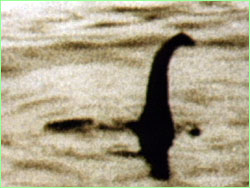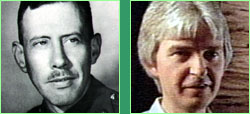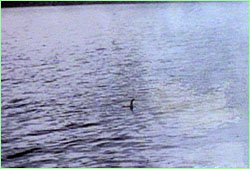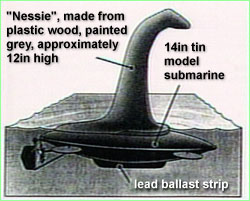 |
 |
 |
Part 3 | back to part 2 Famous Photo Falsified? In the 65 years since the birth of the modern legend, dozens of people have come forward with photographs purporting to show the monster. Most were quickly dismissed as either outright frauds or images of ordinary objects mistaken for monsters. But one photo stood above the rest. Taken in 1934, it shows what appears to be the slender neck of an animal rising from the surface of the water. From the moment it was published in the London Daily Mail, it became the very image of the Loch Ness Monster and, for many, the strongest evidence that Nessie actually exists. One reason the photograph had such an impact on the Loch Ness legend was that it came from such a credible source. The photo was sold to the Daily Mail by a London physician named R. Kenneth Wilson, who said he had taken the picture when he noticed a commotion in the water as he was driving up from London to photograph birds with a friend near Inverness. Few believed that such a respected doctor could be party to a deception.
Ian Wetherell had died by the time Boyd and Martin read the article, but they were able to track down his step-brother, Christian Spurling, in the south of England. Spurling, 93 and near death, confessed. Unhappy with the way he was treated by the Daily Mail after the hippo foot fiasco, Duke Wetherell had set out to get his revenge, enlisting his son and step-son in the plot. First Spurling built a model monster by grafting a head and neck onto the conning tower of a toy submarine. Then Wetherell and his son Ian drove up to the loch and staged the photograph, taking care to include the actual Loch Ness scenery in the background. Finally, to conceal his own role in the hoax, Wetherell persuaded Dr. Wilson, through their common friend Chambers, to have the photo developed and sell it to the Daily Mail as his own. The plot worked better than any of them could have imagined.
Does that finally disprove the monster's existence? Not at all, says Boyd. One of the great ironies of the Loch Ness story is that the man who brought down the most famous piece of evidence remains a firm believer in Nessie. "I am so convinced of the reality of these creatures that I would actually stake my life on their existence," he told NOVA. "I trust my eyesight ... I used to make my living teaching people how to observe, and I know that the thing I saw was not a log or an otter or a wave, or anything like that. It was a large animal. It came heaving out of the water, something like a whale. I mean, the part that was actually on the surface when it stopped rolling through was at least 20 feet long. It was totally extraordinary. It's the most amazing thing I've ever seen in my life, and if I could afford to spend the rest of my life looking for another glimpse of it, I would." Stephen Lyons is the Senior Editor for Program Development at the WGBH Science Unit. He was the co-writer and co-producer of NOVA's "The Beast of Loch Ness." Photos: (2) Daily Mail; (3) ABC News; (4) BBC-Tomorrow's World; (5) North Scene Video; (6) Bob Rines; (7) Adrian Shrine/Bob Rines; (8,11) Fortean Pictures Library; (12) The Sunday Telegraph. Fantastic Creatures | Birth of a Legend Eyewitness Accounts | Experimenting with Sonar Resources | Transcript | Site Map | Loch Ness Home Editor's Picks | Previous Sites | Join Us/E-mail | TV/Web Schedule About NOVA | Teachers | Site Map | Shop | Jobs | Search | To print PBS Online | NOVA Online | WGBH © | Updated November 2000 |
 The "surgeon's photo," published in 1934, became the very image of the Loch Ness Monster.
The "surgeon's photo," published in 1934, became the very image of the Loch Ness Monster.
 The credibility of the surgeon's photo hinged on its source—a respected London doctor named R. Kenneth Wilson (L).
Loch Ness researcher Alastair Boyd (R) helped uncover evidence that the surgeon's photo was part of an elaborate hoax.
The credibility of the surgeon's photo hinged on its source—a respected London doctor named R. Kenneth Wilson (L).
Loch Ness researcher Alastair Boyd (R) helped uncover evidence that the surgeon's photo was part of an elaborate hoax.
 The full, uncropped surgeon's photo, published only once in 1934, was rediscovered by Boyd more than 50 years later.
The full, uncropped surgeon's photo, published only once in 1934, was rediscovered by Boyd more than 50 years later.
 The 93-year-old stepson of Marmaduke Wetherell told Boyd he made the monster in the picture by grafting a plastic wood neck to a toy submarine.
The 93-year-old stepson of Marmaduke Wetherell told Boyd he made the monster in the picture by grafting a plastic wood neck to a toy submarine.